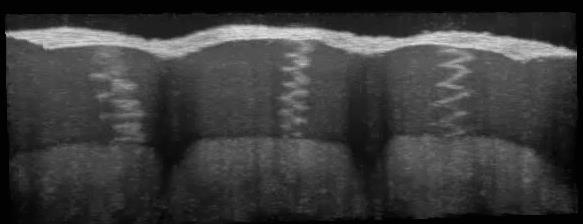
3 minute read
Y. Feldman
Yuri Feldman1, Paul Ben Ishai2 , Alexander Puzenko1 and Noa Betzalel1 1The Hebrew University of Jerusalem, Jerusalem, 9190401, Israel 2Ariel University, Ariel, Israel
Advertisement
Abstract— Detailed studies of the human skin using optical coherence tomography (OCT) have revealed that the morphological structure of our eccrine sweat ducts is remarkably helical. These findings have raised the hypothesis that sweat ducts can be the biological equivalent of helical electromagnetic entities and hence resemble their behavior by receiving and emitting signals in the sub-THz frequency range. Here we show how this hypothesis evolved and was experimentally tested over the recent years, driven by the prospect of developing remote sensors for obtaining information about our physiological and mental state.
F
I. INTRODUCTION
OR more than 50 years there have been a number reports of non-thermal effects of extremely high frequency microwaves (MMW) on biological systems [1]. The interpretation of these phenomena has proven to be elusive. In 2008, we pioneered the hypothesis that the human skin functions as an array of low-Q helical antennas at the sub-THz frequencies [2]. Studies of the morphology of the skin by optical coherence tomography (OCT) revealed that the tips of the sweat ducts that expel the sweat from the gland to the pore at the surface of the skin, have a helical structure (see Figure 1) [3]. Summarizing our main accomplishments thus far, the novel effect of absorption of sub-THz radiation by human sweat ducts, which operate as low-quality-factor helical antennas was predicted, discovered, and initially studied in my lab. Our findings also indicate that electromagnetic reflectance of skin correlates with the emotional and physical human state. Recent experiments conducted by three groups of American, Japanese and British scientists confirm our conclusions in many respects [1].
Figure 1 OCT imaging of the sweat ducts in upper epidermis of the human fingertip in vivo [3].
This, together with the fact that the dielectric permittivity of the dermis is higher than that of the epidermis, brings forward the assumption that, as electromagnetic entities, the sweat ducts could be regarded as imperfect passive helical antennas with both axial and normal modes. By applying basic antenna theory to the typical duct dimensions, the characteristic frequencies were found to be in the sub-THz frequency range. In this talk, we are going to summarise our findings for the last 15 years.
II. RESULTS
Experimentally we showed that the reflectance of the human skin in the sub-THz region depends on the intensity of perspiration, and correlates with levels of human stress (physical, mental and emotional) [4, 5].
Furthermore, in 2014 we detected circular dichroism in the reflectance from the skin, a signature of the axial mode of a helical antenna [6]. The full ramifications of what these findings represent in the human condition are still very unclear. Recently we have conducted a radiometric study of human emissivity around 500 GHz and 507 GHz on 32 volunteers, the preliminary results of which were reported in Ref [7]. Based on these experiments we were able to conclude that the human skin can be considered as an electromagnetic bio-metamaterial, capable of transmitting the human core black body radiation in the sub THz range. Furthermore, the efficiency of this mechanism, reminiscent of a low-Q notch filter, is dependent on the effective ac conductivity and the morphology of the sweat duct.
III. SUMMARY
REFERENCES
[1] A. Kochnev, N. Betzalel, P. Ben Ishai, and Y. Feldman, "Human sweat ducts as helical antennas in the sub-THz frequency range-an overview," Terahertz Science and Technology, vol. 11, pp. 43-56, 2018. [2] Y. Feldman, A. Puzenko, P. Ben Ishai, A. Caduff, and A. J. Agranat, "Human skin as arrays of helical antennas in the millimeter and submillimeter wave range," Physical Review Letters, vol. 100, no. 12, 2008. [3] J. Lademann et al., "Application of optical non-invasive methods in skin physiology: a comparison of laser scanning microscopy and optical coherent tomography with histological analysis," Skin Res. and Tech. , vol. 13, pp. 119-132, 2007. [4] Y. Feldman et al., "The electromagnetic response of human skin in the millimetre and submillimetre wave range," Physics in Medicine and Biology, vol. 54, no. 11, pp. 3341-3363, 2009. [5] E. Safrai et al., "The remote sensing of mental stress from the electromagnetic reflection coefficient of human skin in the subTHz range," Bioelectromagnetics, vol. 33, no. 5, pp. 375-382, Jul 2012, doi: 10.1002/bem.21698. [6] I. Hayut, P. Ben Ishai, A. J. Agranat, and Y. Feldman, "Circular polarization induced by the three-dimensional chiral structure of human sweat ducts," Physical Review E, vol. 89, no. 4, 2014. [7] K. A. Baksheeva et al., "Do h mans shine in he s b TH ?," presented at the 2019 44th International Conference on Infrared, Millimeter, and Terahertz Waves (IRMMW-THz), Paris, France, 2019.









